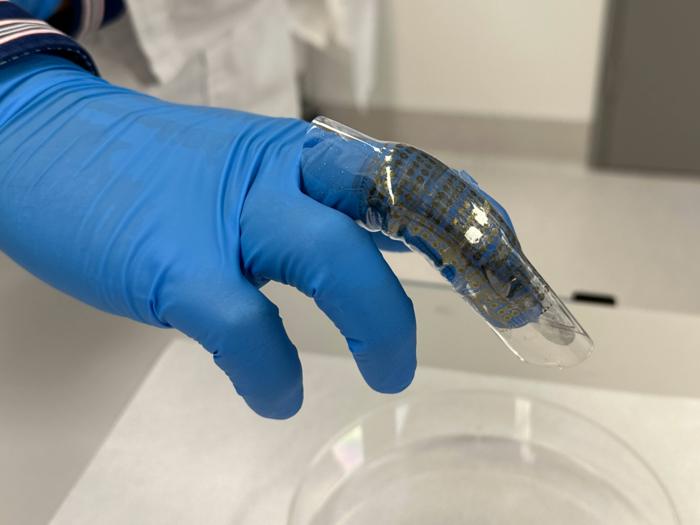| Oct 18, 2023 |
Wearable device makes memories and powers up with the flex of a finger
(Nanowerk News) Researchers have invented an experimental wearable device that generates power from a user’s bending finger and can create and store memories, in a promising step towards health monitoring and other technologies.
|
|
The innovation features a single nanomaterial incorporated into a stretchable casing fitted to a person’s finger. The nanomaterial enabled the device to generate power with the user bending their finger.
|
|
The super-thin material also allows the device to perform memory tasks, as outlined below.
|
Key Takeaways
|
|
Researchers from RMIT University and the University of Melbourne have developed a wearable device that generates power from finger movements and can also perform memory tasks.
The device uses a single type of nanomaterial, bismuth oxide, making it simpler and quicker to manufacture than devices needing multiple materials.
The wearable has potential applications in health monitoring and can be used to memorize personalized data.
Experiments demonstrated the device's responsiveness to human activities and its ability to perform "read," "write," and "erase" memory functions on a nanoscale.
The team aims to collaborate with industry partners for further development and is exploring other metals and alloys for potential use in personalized wearables.
|
 |
| The team’s innovation features a single nanomaterial incorporated into a stretchable casing fitted to a person’s finger. (Image: Seamus Daniel, RMIT University)
|
The Research
|
|
The team’s research is published in Advanced Functional Materials ("Multi-Functional Atomically Thin Oxides from Bismuth Liquid Metal").
|
|
Multifunctional devices normally require several materials in layers, which involves the time-consuming challenge of stacking nanomaterials with high precision.
|
|
The team, led by RMIT University and the University of Melbourne in collaboration with other Australian and international institutions, made the proof-of-concept device with the rust of a low-temperature liquid metal called bismuth, which is safe and well suited for wearable applications.
|
|
Senior lead researcher Dr Ali Zavabeti said the invention could be developed to create medical wearables that monitor vital signs – incorporating the researchers’ recent work with a similar material that enabled gas sensing – and memorise personalised data.
|
|
“The innovation was used in our experiments to write, erase and re-write images in nanoscale, so it could feasibly be developed to one day encode bank notes, original art or authentication services,” said Zavabeti, an engineer from RMIT and the University of Melbourne.
|
What did the device achieve in experiments?
|
|
The team says the study revealed their invention exhibits “exceptional responsiveness to movements associated with human activities, such as stretching, making it a promising candidate for wearable technologies".
|
|
“We tested natural motion behaviour with the device attached to a finger joint, with an average output peak of about 1 volt,” Zavabeti said.
|
|
The device was able to perform the memory functions of “read", “write” and “erase", which included using the RMIT logo and a square-shaped insignia as demonstrations of these capabilities. The device, which was not worn by a user during these memory experiments, wrote and stored the logo and symbol in a space that could fit 20 times within the width of a human hair.
|
How did the team make the invention and how does it work?
|
|
Lead author and PhD student Xiangyang Guo from RMIT, said the team can print layers of bismuth rust, otherwise known as oxide, in just a few seconds.
|
|
“We fundamentally investigated this instant-printing technique for the first time using low-melting point liquid metals,” said Guo, who works under the supervision of Dr Ali Zavabeti and Professor Yongxiang Li.
|
|
The team demonstrated that engineering materials at the nanoscale can present enormous opportunities in a range of functions, from sensing and energy harvesting to memory applications, he said.
|
|
“Bismuth oxide can be engineered to provide memory functionality, which is critical for many applications,” Guo said.
|
|
“The material can act as a semiconductor, meaning it can be used for computation.
|
|
“It is a nanogenerator, meaning it is energy efficient with a green energy supply from environmental vibrations and mechanical movements.”
|
|
Guo said bismuth oxide was likely to cause less irritation to skin, compared with silicon, and it was durable, so it was stretchable and can be integrated into wearable technologies.
|
Next steps
|
|
The team is keen to collaborate with industry partners to further develop and prototype this invention.
|
|
The researchers plan to adapt their approach for other low-temperature liquid and solid metals and alloys that could be developed for personalised wearables.
|

